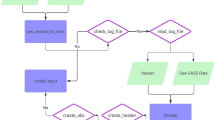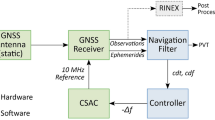Abstract
Precise Point Positioning (PPP) has been demonstrated to be a powerful tool in geodetic and geodynamic applications. Although its accuracy is almost comparable with network solutions, the east component of the PPP results is still to be improved by integer ambiguity fixing, which is, up to now, prevented by the presence of the uncalibrated phase delays (UPD) originating in the receivers and satellites. In this paper, it is shown that UPDs are rather stable in time and space, and can be estimated with high accuracy and reliability through a statistical analysis of the ambiguities estimated from a reference network. An approach is implemented to estimate the fractional parts of the single-difference (SD) UPDs between satellites in wide- and narrow-lane from a global reference network. By applying the obtained SD-UPDs as corrections to the SD-ambiguities at a single station, the corrected SD-ambiguities have a naturally integer feature and can therefore be fixed to integer values as usually done for the double-difference ones in the network mode. With data collected at 450 stations of the International GNSS Service (IGS) through days 106 to 119 in 2006, the efficiency of the presented ambiguity-fixing strategy is validated using IGS Final products. On average, more than 80% of the independent ambiguities could be fixed reliably, which leads to an improvement of about 27% in the repeatability and 30% in the agreement with the IGS weekly solutions for the east component of station coordinates, compared with the real-valued solutions.
Similar content being viewed by others
References
Azuá B, DeMets C and Masterlark T (2002). Strong interseismic coupling, fault afterslip, and viscoelastic flow before and after the October 9, 1995 Colima-Jalisco earthquake: continuous GPS measurements from Colima, Mexico. Geophys Res Lett 29: 1281, doi:10.1029/2002GL014702
Blewitt G (1989). Carrier phase ambiguity resolution for the global positioning system applied to geodetic baselines up to 2000 km. J Geophys Res 94(B8): 10187–10203
Blewitt G, Hammond W, Kreemer C, Plag H-P (2005) From Yucca Mountain local stability to global quaking: GPS point positioning strategies spanning the spatio-temopral spectrum. Paper presented at advances in GPS data processing and modelling for geodynamics, University College London, 9–10 November
Bock H, Hugentobler U, Beutler G (2003) Kinematic and dynamic determination of trajectories for low Earth satellites using GPS. In: Reigber C, Lühr H, Schwintzer P (eds) First CHAMP mission results for gravity, magnetic and atmospheric studies, Springer, Heidelberg, pp 65–69
Calais E, Han JY, DeMets C and Nocquet JM (2006). Deformation of the North American plate interior from a decade of continuous GPS measurements. J Geophys Res 111: B06402, doi:10.1029/2005JB004253
D’Agostino N, Cheloni D, Mantenuto S, Selvaggi G, Michelini A and Zuliani D (2005). Strain accumulation in the southern Alps (NE Italy) and deformation at the northeastern boundary of Adria observed by CGPS measurements. Geophys Res Lett 32: L19306, doi:10.1029/2005GL024266
Dong D and Bock Y (1989). Global positioning system network analysis with phase ambiguity resolution applied to crustal deformation studies in California. J Geophys Res 94(B4): 3949–3966
Gao Y and Shen X (2002). A new method for carrier-phase-based precise point positioning. NAVIGATION J Inst Navig 49(2): 109–116
Ge M, Gendt G, Dick G and Zhang FP (2005). Improving carrier-phase ambiguity resolution in global GPS network solutions. J Geod 79(1–3): 103–110, doi:10.1007/s00190-005-0447-0
Ge M, Gendt G, Rothacher M (2006a) Integer ambiguity resolution for precise point positioning: applied to fast integrated estimation of very huge GNSS networks. Paper presented at VI Hotine-Marussi Symposium of theoretical and computational Geodesy, Wuhan 29 May–2 June 2006
Ge M, Gendt G, Dick G, Zhang FP and Rothacher M (2006). A new data processing strategy for huge GNSS global networks. J Goed 80(4): 199–203, doi:10.1007/s00190-006-0044-x
Gendt G, Dick G, Reigber CH, Tomassini M, Liu Y and Ramatschi M (2003). Demonstration of NRT GPS water vapor monitoring for numerical weather prediction in Germany. J Meteo Societ Jap 82(1B): 360–370
Hammond WC and Thatcher W (2005). Northwest Basin and Range tectonic deformation observed with the global positioning system, 1999–2003. J Geophys Res 110: B10405, doi:10.1029/2005JB003678
Kouba J and Heroux P (2001). Precise point positioning using IGS orbit and clock products. GPS Solut 5(2): 12–28, doi:10.1007/PL00012883
Liu J and Ge M (2003). PANDA Software and its preliminary result of positioning and orbit determination. Wuhan Univ J Nat Sci 8(2B): 603–609
Mader GL (1999). GPS antenna calibration at the national geodetic survey. GPS Solut 3(1): 50–58, doi:10.1007/PL00012780
Moulborne WG (1985) The case for ranging in GPS-based geodetic systems. In: Proceedings first international symposium on precise positioning with the global positioning system, Rockville, 15–19 April pp 373–386
Rizos C (2006) The research challenges of IAG Commission 4 “Positioning & Applications”. Paper presented at VI Hotine-Marussi symposium of theoretical and computational geodesy, Wuhan 29 May–2 June, 2006
Rocken C, Johnson J, Van Hove T and Iwabuchi T (2005). Atmospheric water vapor and geoid measurements in the open ocean with GPS. Geophys Res Lett 32: L12813, doi:10.1029/2005GL022573
Savage JC, Gan W, Prescott WH and Svarc JL (2004). Strain accumulation across the coast ranges at the latitude of San Francisco, 1994–2000. J Geophys Res 109: B03413, doi:10.1029/2003JB002612
Svarc JL, Savage JC, Prescott WH and Ramelli AR (2002). Strain accumulation and rotation in western Nevada, 1993–2000. J Geophy Res 107(B5): 2090, doi:10.1029/2001JB000579
Schaer S, Steigenberger P (2006) Determination and use of GPS differential code bias values. Paper presented at IGS Workshop, Darmstadt 8–11 May 2006
Wu JT, Wu SC, Hajj GA, Bertiger WI and Lichten SM (1993). Effects of antenna orientation on GPS carrier phase. Manuscripta Geodaetica 18(2): 91–98
Wübbena G (1985) Software developments for geodetic positioning with GPS using TI-4100 code and carrier measurements. In: Proceedings of first international symposium on precise positioning with the global positioning system, Rockville, 15–19 April pp 403–412
Xu P (2005). Sign-constrained robust least squares, subjective breakdown point and the effect of weights of observations on robustness. J Geod 79(1–3): 146–159, doi:10.1007/s00190-005-0454-1
Zhang XH and Andersen OB (2006). Surface ice flow velocity and tide retrieval of the amery ice shelf using precise point positioning. J Geod 80(4): 171–176, doi:10.1007/s00190-006-0062-8
Zhu S, Reigber CH and König R (2004). Integrated adjustment of CHAMP GRACE and GPS data. J Geod 78(1–2): 103–108, doi:10.1007/s00190-004-0379-0
Zumberge JF, Heflin MB, Jefferson DC, Watkins MM and Webb FH (1997). Precise point positioning for the efficient and robust analysis of GPS data from large networks. J Geophy Res 102(B3): 5005–5017
Author information
Authors and Affiliations
Corresponding author
Additional information
An erratum to this article can be found at http://dx.doi.org/10.1007/s00190-007-0208-3
Rights and permissions
About this article
Cite this article
Ge, M., Gendt, G., Rothacher, M. et al. Resolution of GPS carrier-phase ambiguities in Precise Point Positioning (PPP) with daily observations. J Geod 82, 389–399 (2008). https://doi.org/10.1007/s00190-007-0187-4
Received:
Accepted:
Published:
Issue Date:
DOI: https://doi.org/10.1007/s00190-007-0187-4




